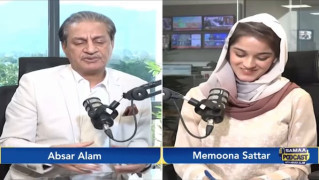اوہو راجہ جی، اپنے وال سٹریٹ کے آرٹیکل پر بھی ذرا غور فرمایئں کہ اس میں شماریات ۲۰۱۴ تک کے ہی استعمال ہوئے ہیں، یعنی ۲ سال سے زیادہ پرانے۔ اس سے بہتر کیا یو این کی ۶ مہینے پہلے کی رپورٹ نہیں ہے؟ اور اگر میرے آرٹیکل کو بہ غور پڑھیں تو میں نے یہ بھی بتایا ہے کہ کیوں جدید طریقوں میں شماریات میں صرف دولت کا شمار نہیں کیا جاتا۔ اگر اس سے کوئی اختلاف ہے تو بتایئں، میں یو این والوں کو بھی سمجھاوں گا کہ راجہ جی کی بات سنیں، یہ عقلی دلیل دے رہے ہیں۔ ویسے جب یہ یو این کی رپورٹ آئی تھی تو احسن اقبال صاحب بھی وہاں موجود تھے، یادگار کے طور پر تصویر پیش خدمت ہے
Sourrce: http://www.pk.undp.org/content/paki...istanis-live-in-multidimensional-poverty.html
!)
The Article was written by a Pakistani. Most of the article written in international Newspapers/Magazines were written by Pakistanies in last 25 years, so whats wrong with this??
2)
WSJ used the statistics from Pakistan Bureau of Statistics while they (PBS) don't know how to collect statistics: For your information on the
website of Pakistan Bureau of Statistics explains how they collect information and what indicators they use to determine the fact:
S.NO INDICATORS FREQUENCY
1 Average household Size Yearly
EDUCATION
1 Population that has ever attended school Yearly
2 Population that has completed primary level or higher Yearly
3 Gross Enrolment rate at Primary, Middle and Matric Levels Yearly
4 Net Enrolment rate at Primary, Middle and Matric Levels Yearly
5 Gross Enrolment rate for Government primary Schools(Excluding Katchi class) Yearly
6 Net Enrolment rate for Government primary Schools(Excluding Katchi class) Yearly
7 Primary level Enrolment in government schools as percentage of total primary enrolment Yearly
8 Enrolment in Government Schools as a percentage of total enrolment at primary level Alternate year(P)
9 Percentage of children 10-18 years old that left school before completing Primary level Alternate year(P)
10 Drop-out rates for the cohort aged 15-19 years Alternate year(P)
11 Primary level enrolment in Private schools Alternate year(P)
12 Reasons for leaving school before completing primary level (10-18 years) Alternate year(P)
13 Reasons for never attending schools (10-18 years) Alternate year(P)
14 Literacy level –Population 10 years and older Yearly
15 Adult Literacy level – Population 15 years and older Yearly
HEALTH
1 Percentage of children aged 12-23 months that have been immunized Yearly
2 Percentage of children aged 12-23 months that have been immunized by type of Antigen – Based on Record Yearly
3 Percentage of children aged 12-23 months that have been immunized by type of Antigen – Based on Record and recall Yearly
4 Children under 5 suffering from diarrhea in past 30 days Yearly
5 Treatment of diarrhea in children under 5 years Yearly
6 Type of practitioner consulted for diarrhea treatment Yearly
7 Infant Mortality rate Alternate year(P)
8 Pregnant women that have received TetnusToxoid injections Yearly
9 Prenatal consultations Yearly
10 Child delivery – Location and Type of Assistance
11 Postnatal consultations Yearly
POPULATION WELFARE
1 Percentage of women aged 15-49 years ever married Alternate year(P)
2 Mean number of children ever born to women aged 15 -49 years Alternate year(P)
3 Mean number of children ever born to ever married women aged 15 -49 years Alternate year(P)
4 Age Specific and Total Fertility Rates – women aged 15-49 years Alternate year(P)
5 Awareness and use of Family Planning methods Alternate year(P)
6 Women currently using Family Planning -CPR Alternate year(P)
7 Commonly known methods of Family Planning Alternate year(P)
8 Reasons for never practicing Family Planning Alternate year(P)
9 Type of family Planning method currently being used Alternate year(P)
10 Sources of family Planning methods Alternate year(P)
11 Attitude towards Family planning methods Alternate year(P)
HOUSING,WATER SUPPLY AND SANITATION
1 Main source of Drinking Water Yearly
2 Percentage of households paying for water Alternate year(P)
3 Who installed the water Delivery system Alternate year(P)
4 Distance to water source Alternate year(P)
5 Type of Toilet used by the households Yearly
6 Type of Sanitation system used Alternate year(P)
7 Percentage Distribution of households by housing tenure Alternate year(D)
8 Percentage Distribution of households by material used for roof Alternate year(D)
9 Percentage Distribution of households by material used for walls Alternate year(D)
10 Percentage Distribution of households by number of rooms Alternate year(D)
11 Percentage Distribution of households by Fuel used for Lighting Alternate year(D)
12 Percentage Distribution of households by Fuel used for cooking Alternate year(D)
PERCEPTION OF ECONOMIC SITUATION
1 Percentage distribution of households by Perception of their Economic situation compared to the year before Alternate year(D)
2 Percentage distribution of households by Perception of their Economic situation of the community compared to the year before Alternate year(D)
3 Percentage Distribution of household satisfaction by Facilities and service use Alternate year(D)
Household Integrated Economic Survey
1 Average Household size and its composition by sex and quintiles Alternate year(P)
2 Average number of earners per household Alternate year(P)
3 Average monthly household consumption expenditure Alternate year(P)
4 Average monthly household Income Alternate year(P)
5 Percentages of monthly household income shares by source and areas Alternate year(P)
6 Percentage of monthly consumption expenditure by Commodity groups Alternate year(P)
7 Percentage of monthly expenditure on 17 major food items Alternate year(P)
8 Percentage distribution of employed persons by industry divisions ,employment status,sex and area Alternate year(P)
9 Percentage distribution of employed persons by occupation Groups, Employment status,sex and area Type of family Planning method currently being used Alternate year(P)
10 Sources of monthly household Receipts(other than income) by quintiles Alternate year(P)
11 Percentage distribution of monthly income by type of employed persons Alternate year(P)[/td]


























